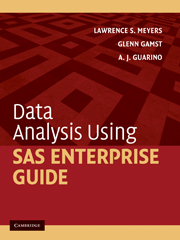Book contents
- Frontmatter
- Contents
- Preface
- Acknowledgments
- I Introducing SAS Enterprise Guide
- II Performing Analyses and Viewing Output
- III Manipulating Data
- IV Describing Data
- V Score Distribution Assumptions
- 12 Detecting Outliers
- 13 Assessing Normality
- 14 Nonlinearly Transforming Variables in Order to Meet Underlying Assumptions
- VI Correlation and Prediction
- VII Comparing Means: The t Test
- VIII Comparing Means: ANOVA
- IX Nonparametric Procedures
- X Advanced ANOVA Techniques
- XI Analysis of Structure
- References
- Author Index
- Subject Index
14 - Nonlinearly Transforming Variables in Order to Meet Underlying Assumptions
Published online by Cambridge University Press: 05 June 2012
- Frontmatter
- Contents
- Preface
- Acknowledgments
- I Introducing SAS Enterprise Guide
- II Performing Analyses and Viewing Output
- III Manipulating Data
- IV Describing Data
- V Score Distribution Assumptions
- 12 Detecting Outliers
- 13 Assessing Normality
- 14 Nonlinearly Transforming Variables in Order to Meet Underlying Assumptions
- VI Correlation and Prediction
- VII Comparing Means: The t Test
- VIII Comparing Means: ANOVA
- IX Nonparametric Procedures
- X Advanced ANOVA Techniques
- XI Analysis of Structure
- References
- Author Index
- Subject Index
Summary
Overview
Most of the statistical procedures we use are based on the assumption that the data are normally distributed, that there are no outliers potentially distorting the results of the analyses, and, if there are two or more distributions involved in the analysis, that the sets of scores have comparable variances (the assumption of homogeneity of variance). If these assumptions are violated, one option available to researchers is to transform the data to force the values to come closer to meeting the assumptions.
Chapter 11 discussed standardizing variables based on existing norms, which is one form of transformation. Standardizing a variable (e.g., to z or linear T scores) is an example of a linear transformation, that is, one preserving the characteristics of the distribution. Thus, a distribution whose values are skewed remains so following the raw scores being converted to z scores. In the present chapter, we discuss transformations that are performed with the intention of modifying the shape of the distribution. These types of transformations are known as nonlinear transformations.
Notes on transformations
To transform data is to perform certain types of mathematical operations on the scores of a variable for each case in the data set. We do this by computing a new variable in much the same way as we showed in Chapter 7 when we computed new variables and in Chapter 11 when we discussed standardizing a variable based on external norms.
- Type
- Chapter
- Information
- Data Analysis Using SAS Enterprise Guide , pp. 135 - 152Publisher: Cambridge University PressPrint publication year: 2009



